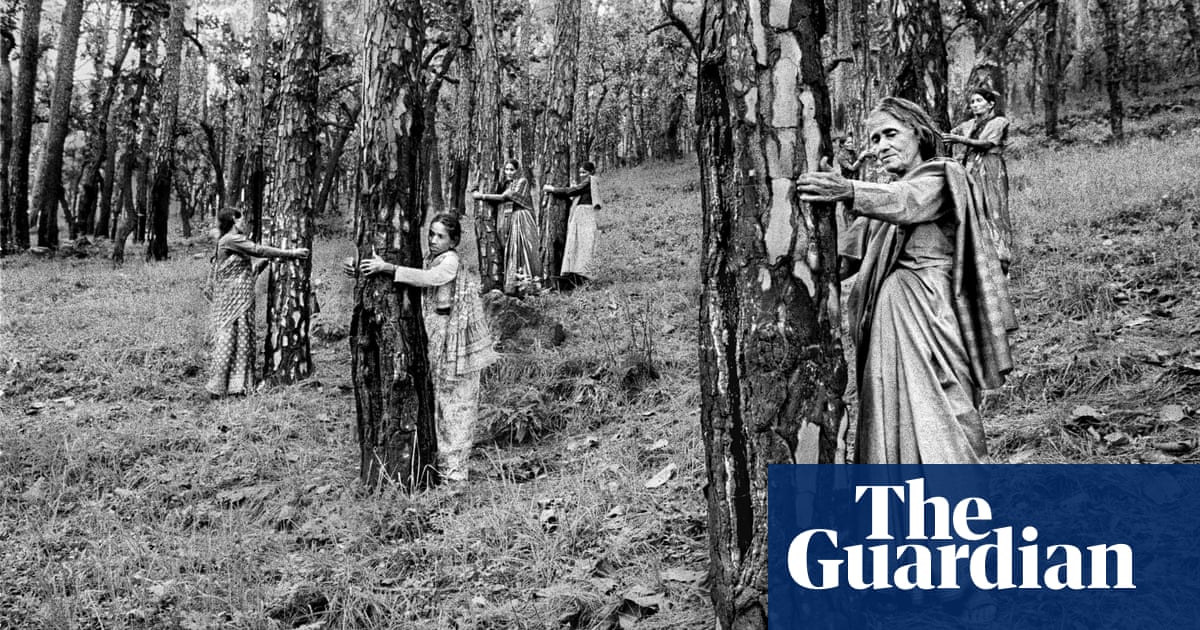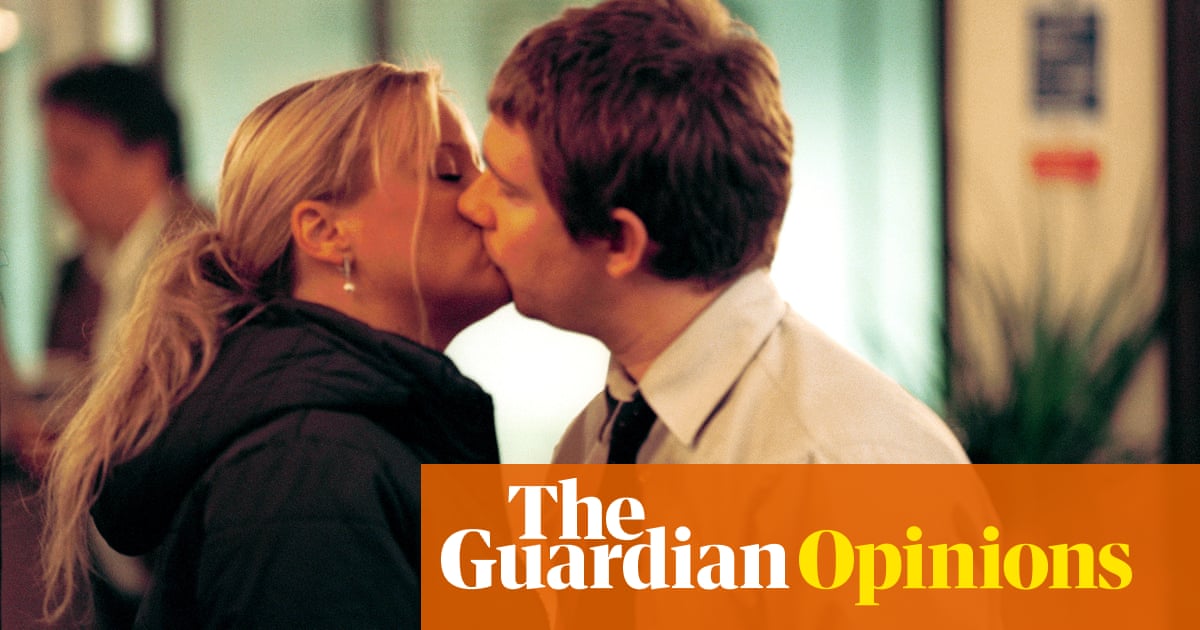
There are photographs of women with their arms wrapped around the trunks of trees in the Himalayas to prevent them from being felled. There are aerial, yet intimate, pictures of open-pit mines and dams that have been blasted across the landscape in western Australia. There are films shot underwater, in warming seas, of melting ice and damaged coral reefs. But “this isn’t a show about climate change”, insists curator Alona Pardo.
The Barbican’s new exhibition, Re/Sisters: A Lens on Gender and Ecology, brings together 250 works of photography, film, performance art and installation, created since the late 1960s by nearly 50 women and gender non-conforming artists from across the world.
“There are a lot of shows being made around this idea of climate change,” says Pardo. “We barely use those words. This is really a show that is shining a light on the nefarious activities that go hand-in-hand with gender-based violence and nature-based violence. And how we begin to bring these two constituent struggles together as interlinked struggles. It becomes much more meaningful for all of us – we can all feel a part of that struggle and part of the resistance.”
Re/Sisters – a play on words to highlight the creative ways in which women resist – is advocating for “empowerment in the face of destruction”. From LaToya Ruby Frazier’s series of photographs of three generations of women affected by the water poisoning crisis in Flint, Michigan, a project she described as a “photo essay between two women – a photographer and a poet – addressing a human-made water crisis in the 21st century”, to newly discovered colour photographs from the women-led anti-nuclear protest camp at Greenham Common in the 1980s by the women-only photography collective Format Photographers, the use of women’s bodies in both producing and protecting life on the planet proliferates.
Maggie Murray, one of its co-founders, told the Guardian: “Some of the most dramatic photographs that we got were of women using their bodies – lying in the road to stop the police and the army arriving, putting their bodies over the fences, through the fences, to try to make a point and to stop the nuclear weapons being delivered.” Murray adds: “It was all sorts of bodies – young, elderly, different classes, races and cultures.”
“We were bodies in the way too,” says Brenda Prince, another member. “We were pointing our cameras at the policemen dragging women along the road. We were there in their way, literally.”
An intersectional ecofeminism is the intellectual bedrock of the Re/Sisters exhibition, which is organised thematically, with sections addressing the politics of extraction, protest, the labour of ecological care, environmental racism and queerness. The idea had been germinating for a while and involved extensive research, says Pardo, who has curated numerous shows at the Barbican on the interlinked themes of art, activism and gender and social justice and who will shortly take up a new role at the Arts Council Collection.
In explaining her thinking behind Re/Sisters, Pardo references Marx’s theory of “primitive accumulation”, the processes essential to the early development of capitalism, such as the dispossession of land. Drawing on the work of feminist academics such as Silvia Federici, Pardo highlights the often overlooked impact on women, including in particular Indigenous women, in this violent period in which, as Marx writes: “Capital comes [into the world] dripping from head to toe, from every pore, with blood and dirt.”
“The way that land has been enclosed,” Pardo says, “the way that land has been sequestered off from common access, and how that has a direct impact on local livelihoods, how bodies navigate through the natural world – how can they go and get the water if all of a sudden, the landed gentry, as they did in the 1800s, begin to siphon off land? What is the impact of that on communities? And what are the impacts of that, in particular, on women’s livelihoods?
“By enclosing, containing, dismantling land, rivers, access to water, we are materially affecting the lives of women – because they’re the ones going to get the water, they’re doing the hard labour, the work.”
And so, Pardo says, “if we liberate the land, then we liberate women.”
Like the wider movement, ecofeminism has developed many strands since the term was coined by the French writer Françoise d’Eaubonne in the 1970s, but at its core is the idea that the oppression of women and the environment are interconnected, and that you cannot eradicate one without the other.
As an antidote to this oppression, early ecofeminist writers emphasised women’s close links with nature – what ecofeminist Carolyn Merchant called “the ancient identity of nature as a nurturing mother”. Through the 80s and 90s, others developed a more socialist or materialist interpretation, while Vandana Shiva led ecofeminism’s critique of colonial development in the Global South.
But then, ecofeminism “fell out of fashion”, Pardo says. It was critiqued for being essentialist and for using gendered terms such as Mother Nature. Western ecofeminists were charged with failing to acknowledge how environmental degradation differently, and increasingly, affected women of colour, and also the resistance of Indigenous women.
Now, argues Pardo, “a radical, intersectional and decolonial brand of ecofeminism” is enjoying a revival. “We’re living in a very different moment,” says Pardo, referencing movements such as Black Lives Matter. “We’re much more willing to accept that we live in a world that’s got systemic injustice, and those different stakeholders are beginning very slowly to have a voice.”
Central to this is the exhibition’s use of an expansive, rather than exclusive, conception of “woman”. “Understanding the earth as a critical medium of struggle has a much longer history of engagement by women, queer and non-binary artists,” says Kathryn Yusoff, professor of inhuman geography at Queen Mary University of London, who advised on the conceptualisation of the show along with climate justice activist Suzanne Dhaliwal
“We don’t use the word female,” Pardo says. “We’ve really tried to be as inclusive as you possibly can be around a very binary term. There’s a whole smörgåsbord of different identities within the show.”
One of the important elements this brings to the exhibition is joy, says Pardo. The gravity and urgency of the climate and ecological crisis is not overlooked, but many of the artworks suggest that environmentalism could learn from feminist and queer art and activism, where humour and playfulness perform important roles as strategies of resistance and survival.
Tee A Corinne’s series Isis shows fleshy vulvas camouflaged across the landscape of Oregon, from tree trunks to clouds. “The earth has the potential to give us lots of pleasure,” says Pardo. “Not just a nice day out at Kew Gardens – but erotic pleasure.”
Then there’s Carolina Caycedo’s Multiple Clitoris, a vibrantly coloured hanging textile, printed with photographs of the water that carves through the Garganta del Diablo canyon, in the Iguazú Falls, between Argentina and Brazil. Rivers are “the veins of the planet”, says Caycedo, whose work examines the impact of dams in South America and has been described by one cultural historian as: “Big Vag meets Big Climate, where toxic masculinity is again symbolic and tongue-in-cheek, but also very literal”.
And The Feminist Land Art Retreat’s short video, Heavy Flow, which shows a volcano erupting as a mocking voiceover provides advice on how it can show off its best angles. It has been read both as a critique of the male-dominated land art tradition and capitalism’s exploitation of women’s bodily insecurities, as well as gently ridiculing the seriousness of feminism itself.
Murray and Prince say it was important to the Format Photographers to record the “empowering” protests at Greenham, where the women used art, including zines, flyers and collective singing, to communicate their feminist message for peace and against militarism and patriarchy. “It was amazing, not only because it was important politically, but it was joyful,” says Murray. “It wasn’t dour and dark and miserable. People were having fun.”
She adds: “A lot of demonstrations in Britain, up to that point, had been rather boring. You know, rather saggy banners or signs written in pencil. Some of the actions [at Greenham], like when the women climbed over the fence, broke through the fence, in the dark, ran across the airfield and danced on the nuclear silos – that was just such a creative thing to do.”
What does Pardo hope people will take away from the show? She is inspired by ecofeminism’s attempts to break down binaries and hopes the audience won’t see climate change as something happening to the planet, but to us too. “We are part of the planet,” she says.
It recalls the work of Brazilian journalist Eliane Brum, whose new book, Banzeiro Òkòtó: The Amazon As the Centre of the World, explores her journey of “reforesting” herself when she moved to live in the rainforest. There, Brum says she learned the power of “joy as a tool of resistance” and “how to make a life possible when we are surrounded by death.”
Or as JEB (Joan E Biren) has said of her striking colour photographs of the Seneca women’s peace camp in upstate New York in the 1980s, which are included in Re/Sisters, her aim as an artist was not only to give these women representation, but to dare people “to imagine another world into existence”.












